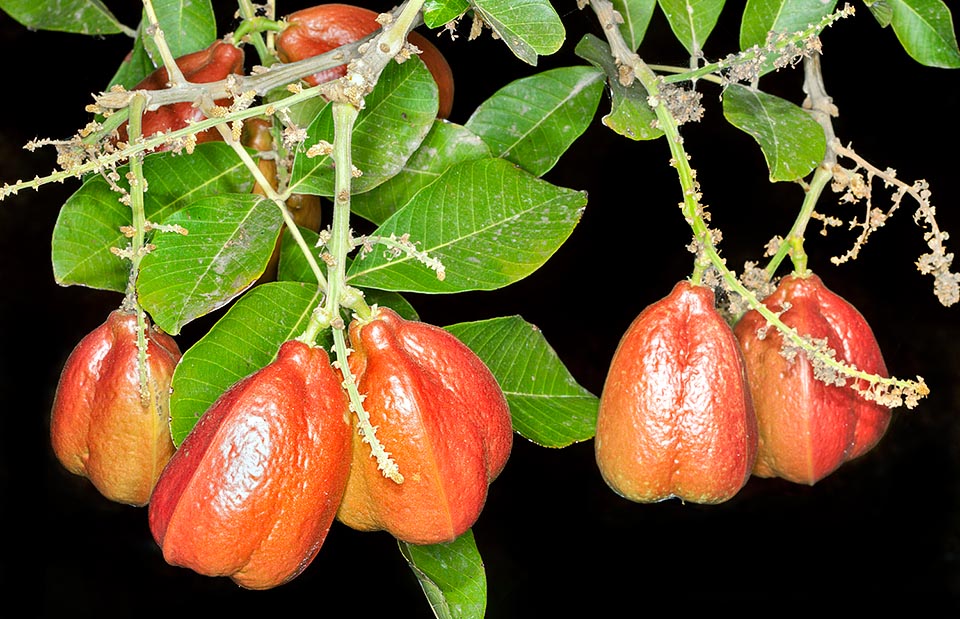Family : Sapindaceae

Text © Pietro Puccio

English translation by Mario Beltramini
The species is native to tropical Africa (Benin, Burkina Faso, Cameroon, Ghana, Guinea, Guinea-Bissau, Ivory Coast, Mali, Nigeria, São Tomé and Principe, Senegal, Sierra Leone and Togo), where it grows in the evergreen as well as in the semi-deciduous forests.
The genus is honoured to the English captain William Bligh (1754-1817); the name of the species is the Latin adjective “sapidus, a, um” = tasty, with obvious reference.
Common names: ackee, akee, akee apple (English); akée, arbre fricassé, fisanier, yeux de crabe (French); castanheiro-da-África (Portuguese); aki, árbol de seso, árbol del huevo, huevo vegetal, merey del diablo, palo de seso, pera roja, seso vegetal (Spanish); Akibaum (German).
The Blighia sapida K.D.Koenig (1806) is an evergreen tree, up to about 15 m tall, with greyish or pale brown smooth bark and thick crown. The leaves, on a 0,5-2,5 cm long petiole, are alternate, paripinnate, up to about 30 cm long, composed by 3-5 pairs of leaflets from oblong to elliptic with entire or slightly wavy margin and pointed apex, 6-18 cm long and 4-8 cm broad, of glossy green colour on the upper page, pale below.
The inflorescences are axillar hanging racemes 5-18 cm long with tiny perfumed flowers, bisexual and also male on the same plant, with white or cream corolla with 5 ovate-lanceolate petals, 0,4 cm long, villous, and 8 stamina 0,5 cm long. The fruit is a fleshy pyriform, dehiscent capsule, more or less tri-lobed, 7-10 cm long and 4-5 cm broad, of yellow suffused with glossy red colour, which when ripe opens longitudinally in three sections exposing three flesh arils (tissues wholly or partly wrapping the seed) reniform, of cream colour, 3-4,5 cm long and about 3 cm broad, and 1-3 globose, black and glossy, seeds. The aril, which is the edible part, is particularly poisonous when unripe, its ingestion causes acute hypoglycaemia that may aver fatal, commonly called “Jamaican vomit” due to the high number of cases, even deadly, reported in this island, it is therefore to be consumed when completely ripe; the other parts of the fruit and in particular the seeds maintain their high toxicity also when completely ripe.

The fruit of Blighia sapida, native to tropical Africa, opens growing and shows 3 arils edible only when ripe. They can be even fatal, as the seeds, if unripe © G. Mazza
The species is cultivated for ornamental purpose and as shade tree in the tropical and subtropical climate countries, where adult plants may bear rare, and for a very short period, drops of the temperature up to about -2 °C, with damage to the crown.
It requires exposition in full sun and is not particular about the soil, provided well drained, with preference for the alkaline ones; it can bloom several times in a year, usually after a long period of rains. For its fruits it is almost exclusively cultivated in Jamaica, where it is the national dish and the species has since long naturalized, the fruit must be gathered perfectly ripe, when naturally and completely open and is about to fall off the tree, the deprived of the seed aril is consumed raw or more frequently cooked, fried after having boiled in salted water or milk.
The toxic substances contained into the unripe aril are hydrosoluble hypoglycins (A and B) that are mostly neutralized when completely ripe and by the exposition to the light; the cooking of the unripe arils does not eliminate the toxic substances, whilst in the ripe ones it contributes in eliminating their residuals. In the seeds, the toxic substances are contained in a greater extent than in the aril and persist even when fully ripe; they are therefore to be carefully eliminated due to their high toxicity.
The fruits are locally utilized in lieu of the soap, as they contain tensioactives (saponin). The wood is hard and resistant to the xylophagous insects and is employed in the constructions, for furniture, cases, tools and handicrafts, locally as firewood and for the production of charcoal. Parts of the plant are used in the traditional medicine.
Synonyms: Akeesia africana Tussac (1808); Akea solitaria Stokes (1812); Cupania akeesia Cambess. ex Spach (1834); Cupania sapida (K.D.Koenig) Oken (1841).
→ To appreciate the biodiversity within the SAPINDACEAE family please click here.
